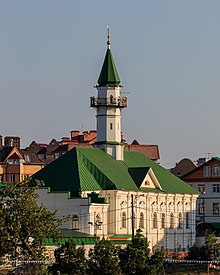History
The earliest examples of Islamic Tatar architecture are located in Bolghar; none of them are in use today. They reflect strong similarities to Central Asian Islamic architecture from which the designs were derived. However, it is believed that design of rural mosques, opposing to Central Asian-like mosques of capital cities, evolve from their ability to withstand the harsh local climate. Many mosques, both stone and wooden were built, according to this style. The oldest of the still active modern Tatar mosques is the Märcani mosque in the Tatar capital of Kazan. Dating from the reign of Catherine the Great, the mosque's minaret is placed in the center of a gabled roof. It is believed that the concept was adopted from traditional rural Tatar mosques. The Märcani mosque is an example of revival Tatar religious architecture as most mosques were destroyed due to the Christianization edict of 1742. [3]
Unification
The edict on unification of church buildings of 1817 was expanded to the mosques in 1831, when the exemplary project was developed and circulated to governorate architectural offices of Kazan, Nizhny Novgorod, Perm and Simbirsk Governorates. Tatar mosques, such as Märcani and Apanay were built in Baroque style. İske Taş and Pink Mosque [ ru ] were contributed to classicism style.
Among the architects, contributed to the mosques building in the 19th century the most notable were Pyatnitsky, Korinfsky, Schmidt, Peske, Romanov, Yermolayev, Pavlov, Parensov, Petondi, Tekhomirov, as well as non-professional architects Mansurov, Foshderebryuggen, Jakobson.
In 1844 another exemplary mosque project was introduced, which was used mostly for urban mosques. The minaret was placed at the northern part of the building, under the door. However, mosques with minarets on the roof are constructed till today.
This page is based on this
Wikipedia article Text is available under the
CC BY-SA 4.0 license; additional terms may apply.
Images, videos and audio are available under their respective licenses.







